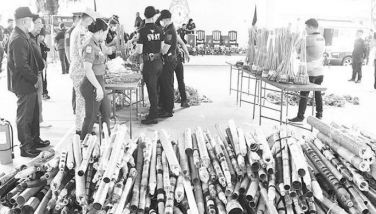A high school lesson, updated
In my second year high school class at St. James Academy in Padre Burgos, Southern Leyte, we had a subject called General Science. Mrs. Emeliana Borces (she is now with the Lord) was our teacher. While she was a good teacher, I was more interested in History, handled by an unassuming instructor in Mr. Perfecto Tabamo, now also in heaven. Yet, one day Mrs. Borces said something that I recalled when for few succeeding days last week we experienced constantly recurring flashfloods. Such inundations are recognized as among the biggest problems in our city. In an authoritative voice Mrs. Borces said then “in order to solve a problem, you must first understand the problem.”
When I came to Cebu City in 1965 for my third year high school, we did not witness flooding in our streets. We lived in Parian, a low-lying part of the city but no stormy rain caused flooding in our area. In fact, Colon Street would still be relatively dry even after heavy rains. But a Facebook post last week showed a heart-shattering view of Colon Street looking like a canal in Venice, without gondolas. So, why do we have this problem now?
Vacant lots. History tells us that shortly after World War II, there were visible uninhabited places in the city. Some areas were unoccupied even before the war while in others, structures were pulverized by the bombs, cannons, and resulting fires from opposing armies. It was safe to assume that there were more open spaces than those where buildings were erected on.
Few buildings. In the late ‘40’s to the early ‘60’s, most of the commercial structures as well as residential homes were erected along the city streets. No houses were built in the inner portions of the city. Take the case of Barangay Lahug. There was a wide and open area called city garage where no houses were built. Actually while the name made us believe that it was the repository of vehicles, it was too large a space for the few vehicles. Today it seems to be wholly occupied by settlers.
Trees. The city was filled with trees. Sambag, Tugas, Caimito, and many other species grew up in almost every nook. The present Gen. Maxilom Avenue, for instance, was called Mango Avenue because there were mango trees growing on both sides of the street from somewhere near St. Theresa’s College all the way to where the City Health building now stands.
Drainage system. After the war, the government installed a drainage system using culverts of two feet in diameter. That system was enough to drain the rain water straight to the sea. Since there were more vacant areas than buildings, when it rained hard, the soil would just absorb the rain and the few buildings would funnel the water to the drainage.
Today, almost every square meter of our land is occupied by tall condominiums and squatter shanties alike. There are no more vacant areas to absorb the rain. On every space, structures are standing and these buildings drain huge volume of water to the canals. Worse, the trees which used to help the soil to retain the rain, are gone. Unfortunately, the size of the antiquated culverts is too small for the ever-increasing volume of water.
I am sure that our present leaders have learned, in their own high school days, the same lesson Mrs. Borces imparted to us. “Understand the problem”. The problem of city floods can be traced to the absence of trees, the construction of buildings on every square meter of our land, the draining of waters from these buildings to the city canals and drainage, and our small canals.
- Latest

























